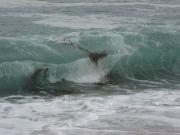Radio Program
Our regular Science and the SeaTM radio program presents marine science topics in an engaging two-minute story format. Our script writers gather ideas for the radio program from the University of Texas Marine Science Institute's researchers and from our very popular college class, Introduction to Oceanography, which we teach to hundreds of non-science majors at The University of Texas at Austin every year. Our radio programs are distributed at to commercial and public radio stations across the country.
A calm day on the beaches of the Pacific Northwest can turn deadly in a hurry. A single large wave can rush ashore, running inland up to 50 yards farther than the previous waves. Anyone who’s too close can be washed into the ocean. In fact, more than two dozen beachgoers have been killed by such waves in the last decade and a half.
An ancestor of modern-day whales may have paddled across the Atlantic Ocean like an otter. And when it reached the Americas, it could have walked out on its back legs.
Scientists discovered the fossilized skeleton of this odd creature in the desert of Peru, near the Pacific Ocean. It was in layers of sediment that were almost 43 million years old. That makes it the oldest creature of its kind found in the southern hemisphere or in the Pacific Ocean.
Like its garden-variety namesake, the sea cucumber doesn’t get around much. Most species appear to spend their entire adult lives on the same patch of sea floor. But recent research suggests that at least some of them may get out more. They’ve been seen to drift along like tumbleweeds.
Sea cucumbers are named for their resemblance to the vegetable. They have long, tube-shaped bodies with a mouth at one end. Tentacles around the mouth allow them to scoop up mud and sand, which they filter for food.
We Americans love our shrimp, salmon, and canned tuna -- we eat more of those than any other type of seafood. Overall, in 2017 we consumed about 16 pounds of fish and shellfish per person -- just below the all-time high.
Fishing just isn’t what it used to be -- commercial fishing, that is. For much of the last century, the world’s fleets brought in more fish and shellfish every decade. Since about 1990, though, the catch has remained about the same. And one recent study logged a four percent decline in the productivity of the world’s main fisheries between 1930 and 2010.
It’s probably not surprising that a critter known as a toadfish can be a bit rude. A couple of studies in recent years have found that male toadfish “grunt” when their neighbors are trying to court females. That makes a neighbor’s call a bit less attractive -- perhaps giving the grunter an advantage in finding a mate.
The studies targeted a species of toadfish along the Atlantic coast of Central and South America. It lives in shallow coastal waters, in areas with rocky or sandy bottoms.
A few strands of kelp washing up on a beach usually isn’t much cause for alarm. But when two clumps of southern bull kelp were found in Antarctica in early 2017, scientists were concerned. While the kelp didn’t constitute a full-scale invasion, it did suggest that invaders might be a bigger threat in the years ahead.
Antarctica is well isolated from the rest of the world. Strong winds and currents in the surrounding ocean tend to keep creatures from other lands away. In fact, scientists had thought the Southern Ocean was like a steel curtain, keeping Antarctic shores untouched.
What do you get if you give a young rainbow trout a good travel agent? A steelhead trout. While most rainbow trout spend their entire lives in rivers and streams, some head out to sea. Such travelers are known as steelheads. It’s unclear, though, exactly what causes one trout to stay at home and another to seek the open ocean.
Both forms are types of salmon. They’re found from the northwestern United States across to northeastern Asia. They hatch in fast-flowing waterways with gravel bottoms, where the eggs can be covered up to protect them from predators.
If you like the deep blues and rich blue-greens of the oceans, then you might really enjoy the view at the end of the century. A recent study says the blues could be bluer and the greens greener. While that might be aesthetically pleasing, it's not a good thing for life.
A couple of factors determine ocean color: the water itself, and the stuff it contains. Water molecules absorb redder wavelengths of light and reflect bluer wavelengths, making water look blue.
The grunt sculpin doesn’t do much of anything the conventional way. The little fish usually walks instead of swims. It frequently lives in “homes” that were abandoned by other creatures. And when it comes to courting and raising a family, the female pursues the male, who does most of the egg-sitting.
Grunt sculpin get their name from a “grunt” they make when they’re pulled out of the water. They live along the Pacific coasts of Japan and the United States. They’re found in tidepools and just offshore, usually in shallow waters. They top out at about three inches long.












